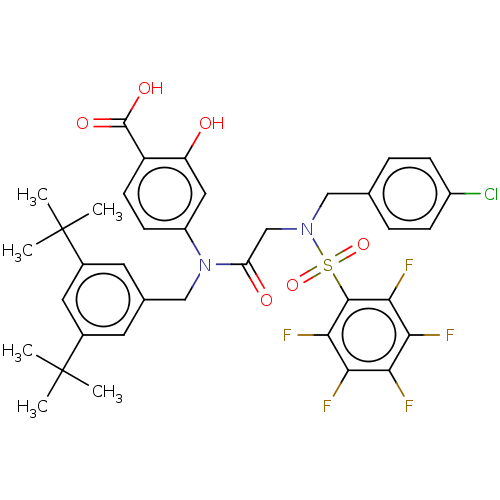BDBM50033887 CHEMBL3358611
SMILES CC(C)(C)c1cc(CN(C(=O)CN(Cc2ccc(Cl)cc2)S(=O)(=O)c2c(F)c(F)c(F)c(F)c2F)c2ccc(C(O)=O)c(O)c2)cc(c1)C(C)(C)C
InChI Key InChIKey=AMYVQFXKGYPZLQ-UHFFFAOYSA-N
Activity Spreadsheet -- Enzyme Inhibition Constant Data from BindingDB
 Found 4 hits for monomerid = 50033887
Found 4 hits for monomerid = 50033887
TargetSignal transducer and activator of transcription 5B(Homo sapiens (Human))
University Of Toronto Mississauga
Curated by ChEMBL
University Of Toronto Mississauga
Curated by ChEMBL
Affinity DataKi: 146nMAssay Description:Inhibition of STAT5B SH2 domain (unknown origin)-5-FAM-GpYLVLDKW interaction compound treated for 15 mins by fluorescent polarization assayMore data for this Ligand-Target Pair
TargetSignal transducer and activator of transcription 3(Homo sapiens (Human))
University Of Toronto Mississauga
Curated by ChEMBL
University Of Toronto Mississauga
Curated by ChEMBL
Affinity DataKi: 1.44E+5nMAssay Description:Inhibition of STAT3 (unknown origin)-5-FAM-GpYLVLDKW interaction compound treated for 15 mins by fluorescent polarization assayMore data for this Ligand-Target Pair
TargetSignal transducer and activator of transcription 3(Homo sapiens (Human))
University Of Toronto Mississauga
Curated by ChEMBL
University Of Toronto Mississauga
Curated by ChEMBL
Affinity DataKd: 287nMAssay Description:Binding affinity to full-length His-tagged STAT3 (unknown origin) by surface plasmon resonance assayMore data for this Ligand-Target Pair
TargetSignal transducer and activator of transcription 5B(Homo sapiens (Human))
University Of Toronto Mississauga
Curated by ChEMBL
University Of Toronto Mississauga
Curated by ChEMBL
Affinity DataKd: 42nMAssay Description:Binding affinity to full-length His-tagged STAT5B (unknown origin) by surface plasmon resonance assayMore data for this Ligand-Target Pair
